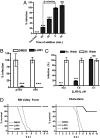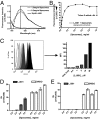A broad-spectrum antiviral targeting entry of enveloped viruses
- PMID: 20133606
- PMCID: PMC2840368
- DOI: 10.1073/pnas.0909587107
A broad-spectrum antiviral targeting entry of enveloped viruses
Abstract
We describe an antiviral small molecule, LJ001, effective against numerous enveloped viruses including Influenza A, filoviruses, poxviruses, arenaviruses, bunyaviruses, paramyxoviruses, flaviviruses, and HIV-1. In sharp contrast, the compound had no effect on the infection of nonenveloped viruses. In vitro and in vivo assays showed no overt toxicity. LJ001 specifically intercalated into viral membranes, irreversibly inactivated virions while leaving functionally intact envelope proteins, and inhibited viral entry at a step after virus binding but before virus-cell fusion. LJ001 pretreatment also prevented virus-induced mortality from Ebola and Rift Valley fever viruses. Structure-activity relationship analyses of LJ001, a rhodanine derivative, implicated both the polar and nonpolar ends of LJ001 in its antiviral activity. LJ001 specifically inhibited virus-cell but not cell-cell fusion, and further studies with lipid biosynthesis inhibitors indicated that LJ001 exploits the therapeutic window that exists between static viral membranes and biogenic cellular membranes with reparative capacity. In sum, our data reveal a class of broad-spectrum antivirals effective against enveloped viruses that target the viral lipid membrane and compromises its ability to mediate virus-cell fusion.
Conflict of interest statement
The authors declare no conflict of interest.
Figures





Comment in
-
Viral membranes: an emerging antiviral target for enveloped viruses?Expert Rev Anti Infect Ther. 2010 Jun;8(6):635-8. doi: 10.1586/eri.10.51. Expert Rev Anti Infect Ther. 2010. PMID: 20521891
Similar articles
-
A mechanistic paradigm for broad-spectrum antivirals that target virus-cell fusion.PLoS Pathog. 2013;9(4):e1003297. doi: 10.1371/journal.ppat.1003297. Epub 2013 Apr 18. PLoS Pathog. 2013. PMID: 23637597 Free PMC article.
-
Inhibition of an Aquatic Rhabdovirus Demonstrates Promise of a Broad-Spectrum Antiviral for Use in Aquaculture.J Virol. 2017 Jan 31;91(4):e02181-16. doi: 10.1128/JVI.02181-16. Print 2017 Feb 15. J Virol. 2017. PMID: 27903801 Free PMC article.
-
Broad-Spectrum Antiviral Entry Inhibition by Interfacially Active Peptides.J Virol. 2020 Nov 9;94(23):e01682-20. doi: 10.1128/JVI.01682-20. Print 2020 Nov 9. J Virol. 2020. PMID: 32907984 Free PMC article.
-
Broad-spectrum antivirals against viral fusion.Nat Rev Microbiol. 2015 Jul;13(7):426-37. doi: 10.1038/nrmicro3475. Epub 2015 Jun 15. Nat Rev Microbiol. 2015. PMID: 26075364 Free PMC article. Review.
-
Viral Entry Inhibitors Targeting Six-Helical Bundle Core against Highly Pathogenic Enveloped Viruses with Class I Fusion Proteins.Curr Med Chem. 2022;29(4):700-718. doi: 10.2174/0929867328666210511015808. Curr Med Chem. 2022. PMID: 33992055 Review.
Cited by
-
Lipid-Centric Approaches in Combating Infectious Diseases: Antibacterials, Antifungals and Antivirals with Lipid-Associated Mechanisms of Action.Antibiotics (Basel). 2023 Dec 11;12(12):1716. doi: 10.3390/antibiotics12121716. Antibiotics (Basel). 2023. PMID: 38136750 Free PMC article. Review.
-
Chemical and Structural Aspects of Ebola Virus Entry Inhibitors.ACS Infect Dis. 2015 Jan 9;1(1):42-52. doi: 10.1021/id500025n. Epub 2014 Dec 18. ACS Infect Dis. 2015. PMID: 25984565 Free PMC article.
-
SAR Based Optimization of a 4-Quinoline Carboxylic Acid Analog with Potent Anti-Viral Activity.ACS Med Chem Lett. 2013 Jun 13;4(6):517-521. doi: 10.1021/ml300464h. ACS Med Chem Lett. 2013. PMID: 23930152 Free PMC article.
-
Distinct functional and conformational states of the human lymphoid tyrosine phosphatase catalytic domain can be targeted by choice of the inhibitor chemotype.J Comput Aided Mol Des. 2011 Sep;25(9):873-83. doi: 10.1007/s10822-011-9469-2. Epub 2011 Sep 9. J Comput Aided Mol Des. 2011. PMID: 21904909 Free PMC article.
-
An effective inactivant based on singlet oxygen-mediated lipid oxidation implicates a new paradigm for broad-spectrum antivirals.Redox Biol. 2020 Sep;36:101601. doi: 10.1016/j.redox.2020.101601. Epub 2020 Jun 8. Redox Biol. 2020. PMID: 32535542 Free PMC article.
References
-
- Tam RC, Lau JY, Hong Z. Mechanisms of action of ribavirin in antiviral therapies. Antivir Chem Chemother. 2001;12:261–272. - PubMed
-
- Bekisz J, Schmeisser H, Hernandez J, Goldman ND, Zoon KC. Human interferons alpha, beta and omega. Growth Factors. 2004;22:243–251. - PubMed
-
- de Veer MJ, et al. Functional classification of interferon-stimulated genes identified using microarrays. J Leukoc Biol. 2001;69:912–920. - PubMed
-
- Sen GC. Viruses and interferons. Annu Rev Microbiol. 2001;55:255–281. - PubMed
-
- Hong Z, Cameron CE. Pleiotropic mechanisms of ribavirin antiviral activities. Prog Drug Res. 2002;59:41–69. - PubMed
Publication types
MeSH terms
Substances
Grants and funding
- U01 AI082100/AI/NIAID NIH HHS/United States
- AI065359/AI/NIAID NIH HHS/United States
- AI082100/AI/NIAID NIH HHS/United States
- AI069317/AI/NIAID NIH HHS/United States
- T32 AI007323/AI/NIAID NIH HHS/United States
- AR053463/AR/NIAMS NIH HHS/United States
- AI070495/AI/NIAID NIH HHS/United States
- P30 AI028697/AI/NIAID NIH HHS/United States
- T32 AR053463/AR/NIAMS NIH HHS/United States
- U01 AI070495/AI/NIAID NIH HHS/United States
- R01 AI059371/AI/NIAID NIH HHS/United States
- R01 AI069317/AI/NIAID NIH HHS/United States
- AI07323/AI/NIAID NIH HHS/United States
- R21 AI084090/AI/NIAID NIH HHS/United States
- AI028697/AI/NIAID NIH HHS/United States
- U54 AI065359/AI/NIAID NIH HHS/United States
LinkOut - more resources
Full Text Sources
Other Literature Sources
Medical

